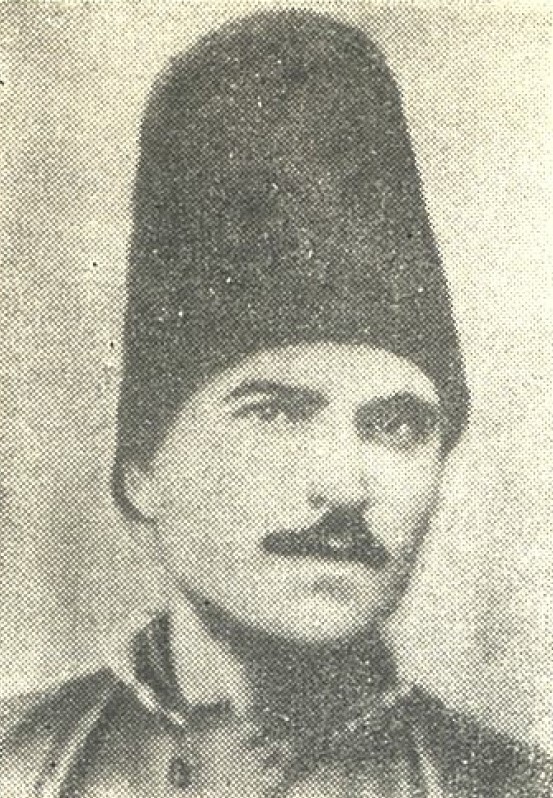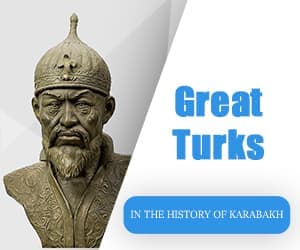Qarabag.com presents the material about Gasim bey Zakir, the founder of critical realism and satirical direction in Azerbaijani poetry. The article is divided into two parts: The poet’s life and creative activity

Poet’s life
A lyric poet and satirist Gasim bey Ali bey oglu Javanshir, who is famous under the pseudonym “Zakir” (“a person who glorifies God”), was born in 1784 in Shusha in a noble family. His great-grandfather was the brother of Panah Ali Khan, a founder of the Karabakh khanate. Additionally, it is mentioned in “Qafqaz” newspaper that Gasim Bey was a descendant of Sahl Ali Bey, the uncle of Panah Ali Khan.
[Prominent figures of Azerbaijan Gasim bey Zakir. 1984, p. 5-6;48]
[F. Kocharlinsky Literature of Azerbaijani Tatars. 1903, p. 22-23]
[“Bakinskiy rabochiy” publication №55 (10916) 07.03.1957., p. 2]
[Streets of Baku are named after them. 1962, p. 159]
[F.S. Gasimzade. The essays on the history of the 19th century Azerbaijani literature. 1962, p. 127]
[“Qafqaz” newspaper №3. 07(19).01.1868, p. 4]
Zakir got his first education at a madrasa in Shusha, where he learned the Persian language perfectly.
[G.Zakir. Selected works. 1971, p. 7]
[F.S. Gasimzade. The essays on the history of the 19th century Azerbaijani Literature. 1962, p. 127-128]
During the First Russo-Persian War (1804-1813) and the Second Russo-Persian War (1826-1828) Gasim bey Zakir participated in military operations against Iran in the ranks of the Caucasian Muslim volunteer cavalry unit of the tsarist army. Later, in a letter dated April 29, 1828, addressed to Major General Ivan Nikolayevich Abkhazov, the head of the military district of the Transcaucasian Muslim provinces, he wrote:
“In 1806, when Abbas Mirza’s army entered Karabakh, me and General Lisanevich fought against Abbas Mirza’s troops on the banks of the Khonsha River (Khonashin) and we forced them to retreat.”
In another letter dated April 24, 1828, addressed to General Ivan Fedorovich Paskevich, the commander-in-chief of the Separate Caucasian Corps, Zakir described his services in this war in detail:
“…In 1806, when Abbas Mirza came to Karabakh with his troops and was eventually defeated, I made a way from Shusha to Mugri (currently Meghri, Armenia) under the command of Major General (Lisanevich).The Kizilbash wanted to take the ilats (nomadic herders) of Karabakh with them. I did good service there and, according to the order of the major general, I went 12 agaches (agach – a unit of measurement in the South Caucasus, about 6-7 km by horse and 3-4 km by foot) and infiltrated the ilats, warned them and prevented them from leaving. Kizilbash army was disbanded and ilats returned, the people of those places calmed down.”
[Prominent figures of Azerbaijan. Gasim bey Zakir. 1984, p. 15-17;47]
In 1812, Zakir participated in the defense of Shusha and the Lankaran campaign of tsarist general Pyotr Kotlyarevsky. In July 1826, Zakir participated in the defense of Shusha again, and in 1827 he was wounded in the hand. On March 15, 1828, by order of the Russian Emperor Nicholas I, Zakir was awarded a silver medal for his bravery.
[Prominent figures of Azerbaijan. Gasim bey Zakir. 1984, p. 15-47-49]
It is mentioned in “Qafqaz” newspaper that Zakir also took part in military operations against the highlanders: “Gasim bey Zakir served in the militia. He distinguished himself bravely, especially in the expedition against the Jar Lezgins under the leadership of Colonel Miklashevsky.”
[“Qafqaz” newspaper №3. 07(19).01.1868, p. 4]
[G.Zakir. Selected works. 1971, p. 216-218]
In summer Zakir lived in Shusha, and at other times in the village of Khindiristan of the current Agdam district, where he was engaged in agriculture. The village was gifted to him by his friend Mehdi Gulu, the last khan of Karabakh.
[F.S. Gasimzade. The essays on the history of the 19th century Azerbaijani Literature. 1962, p. 127-128]
[F. Kocharlinsky. Literature of Azerbaijani Tatars. 1903, p. 23]
[G.Zakir. Selected works. 1971, p. 7-8]
[“Qafqaz” newspaper №3. 07(19).01.1868, p. 4]
Gasim bey Zakir criticized beys, tsarist authorities and representatives of the clergy, thus, he gained many enemies among them. Jafargulu Aga, who was one of Zakir`s enemies, made friends with him earlier, however, he started to be a personal enemy against him afterwards and he exposed his lifestyle, his behavior with the villagers etc. One of the main reasons for the deterioration of their friendship was that Gasim bey Zakir being under his relative Mehdi Gulu Khan`s care, with whom Jafargulu Aga had a blood feud (in 1806, Mehdi Gulu Khan was appointed Khan of Karabakh by the Russian government, preceding his nephew Jafargulu Agha, who was claimed to be the heir). Not coming to terms with his destiny, the latter attempted to topple his uncle from the Karabakh throne. In the book “Gasim bey Zakir and his contemporaries” of 2013 noted that there was another reason of enmity between Zakir and Jafargulu Agha: the latter did not keep his word on the incident involving Zakir`s brother’s sons – Behbud and Rustam.
“Zakir’s nephew, Behbud, who was persecuted by the tsarist officials due to disobeying the authorities, escaped from prison. Behbud had been imprisoned by the order of the noble ruler Tarkhan Mouravov (the head of the Karabakh Uyezd), as they were afraid that he would take revenge for his brother Rustam, who died being shot when he escaped with other prisoners. The enemies told the authorities that if Zakir wishes, he can find Behbud and hand him over to prisoners.”
Based on the foregoing, it follows that Zakir’s enemies decided to take action after the death of Mehdi Gulu Khan, Gasim bey Zakir`s one and only protector. The above-mentioned events were the most suitable reasons for reprisal of Zakir.
[E.İsmayilov. The Caucasus and Globalization. Volume 8, Issue 1-2, 2014, Articles: Karabakh khans: Origin of the dynasty, subjugation of the khanate to the Russian Empire to the Russian Empire and abolition of the khanate. P. 158-159; 167]
[E. İsmayilov The Caucasus and Globalization. Volume 8, Issue 3-4, 2014., Articles: Khans of Karabakh: Genealogy of the Great Line of the Dynasty. p. 138]
[Prominent figures of Azerbaijan. Gasim bey Zakir. 1984. p. 104-108]
[V.Potto. Caucasian War in essays, episodes, myths, and biographies. Volume 3, 1888. p. 420]
[G.Zakir. Selected works. 1971, p. 8;113;119;173-177;182;186;223;226]
[F.S. Gasimzade. The essays on the history of the 19th century Azerbaijani Literature. 1962, p. 142-146]
[“Qafqaz” newspaper №3. 07(19).01.1868, p. 4]
[R.Karimov. Gasim bey Zakir and his contemporaries. 2013., p. 126;135]
In October 1849, Zakir and his family were arrested and accused of sheltering Behbud, who had escaped from the tsarist authorities. He was sent to Baku prison, and his son and nephew were banished to Siberia. His estate in Khindiristan was plundered and all his property was confiscated.
In a letter dated October 24, 1850, addressed to the head of the Transcaucasian civil affairs department, Zakir wrote the following:
“For more than a year, knyaz Tarkhan Mouravov, the head of Shusha city, provoked by colonel Jafargulu Agha, with a force of about 700 horsemen, including Jafargulu Agha himself, entered the village of Khindiristan. Me and my innocent people were looted without a trial or investigation. Сonsequently, we were impoverished and lived in poverty. I do believe that there is no one on this earth suffering the same troubles as we did.”
[Streets of Baku are named after them. 1962, p. 159]
[F. Kocharlinsky Literature of Azerbaijani Tatars. 1903, p. 23-24]
[F.S. Gasimzade. The essays on the history of the 19th century Azerbaijani Literature. 1962, p. 128-129]
[Azerbaijani poets. 1962., p. 217]
[G.Zakir. Selected works. 1971, p. 186]
After three months of confinement in Baku, Zakir was released from prison with the help of his friends, Azerbaijani writers – Mirza Fatali Akhundov and Ismayil bey Gutgashinli, the russian official Mikhail Petrovich Kolyubyakin and other georgian knyazes.
[G.Zakir. Selected works. 1971, p. 8-9;224]
[F. Kocharlinsky Literature of Azerbaijani Tatars. 1903, p. 24]
[Prominent figures of Azerbaijan. Gasim bey Zakir. 1984. p. 130-131]
[F.S. Gasimzade. The essays on the history of the 19th century Azerbaijani Literature. 1962, p. 129]
Imprisonment, exile, the village and property being plundered, being separated from his loved ones undermined his health. In his last years, he lived under police control, in poverty and limitations. Gasim bey Zakir died in Shusha in 1857. The “Qafqaz” newspaper mentioned the following: “Zakir’s son Najafgulu bey and his other nephew Iskender bey were sent to live in Russia. This experience had a shattering effect on Zakir, and he could not endure this tragedy and as a result died.” Gasim bey Zakir was buried in Mirza Hasan cemetery in Shusha.
[Prominent figures of Azerbaijan Gasim bey Zakir. 1984. p. 214]
[F.S. Gasimzade. The essays on the history of the 19th century Azerbaijani Literature. 1962, p. 129]
[H. Aliyev. Azerbaijani literature. Historical essay. 2010, p. 2010]
[H. Sadikhova. History of the city of Shusha. 2004, p. 125]
[G.Zakir. Selected works. 1971, p. 9]
[“Qafqaz” newspaper №3. 07(19).01.1868, p. 4]
[“Bakinskiy rabochiy” publication №55 (10916) 07.03.1957., p. 2]
In 1984, a monument was erected over his grave on the occasion of the celebration of the 200th anniversary of Gasim bey Zakir.
[Prominent figures of Azerbaijan. Gasim bey Zakir. 1984. p. 215]
His house and the monument above the poet’s grave were wrecked, after the occupation of Shusha by the armed forces of Armenia in 1992.
[Prominent figures of Azerbaijan. Gasim bey Zakir. 1984. p. 64-65]
 Creativity
Creativity
From an early age, Zakir started to write poems. His first poem was published in the newspaper “Qafqaz” in 1854. Zakir usually wrote lyrical couplets, ghazals, satire, and fables.
[“Bakinskiy rabochiy” newspaper №55 (10916) 07.03.1957., p. 2]
[G.Zakir. Selected works. 1971, p. 7]
[Azerbaijani poets. 1962., p. 217]
The poet wrote his lyrical poems substantially in the form of couplets (ashug form of poetry). Simplicity of his language and use of this form made his poetry popular. One of his famous couplets is “Cranes” poem. Azerbaijani literary critic, Firudin bey Kocharli evaluated Zakir’s artistic activities as follows:
“Karabakh is like Parnas for Azerbaijani poets and a nest is built for high-flying poets on the heights of the Shusha rocks.” Without any doubt, the first and most prominent one among them is Gasim bey Zakir.”
[F. Kocharlinsky. Literature of Azerbaijani Tatars. 1903, p. 23]
[Streets of Baku are named after them. 1962, p. 159]
[H. Sadikhova. History of the city of Shusha. 2004, p. 125]
Gasim bey Zakir is one of the most prominent representatives of Molla Panah Vagif school of poetry. In this sense, Mirza Fatali Akhundov wrote:
“During the trip, I found a number of works by Molla Panah Vagif in Karabakh… I also met Gasim bey Sarijali Javanshir. His poems written in Turkish aroused amazement and pleasure in me. The difference between these two poets is that even if Molla Panah Vagif was born before Gasim bey and he is considered to be Zakir`s predecessor, the works of Gasim bey have an aesthetic influence and they are of much beauty. Gasim bey talks about his lover with such beauty and high spirit, he has a sincere conversation that the reader becomes fascinated by. He describes the events, moments, the spirit of modernism, nuances of young parts so vividly, full of color that the reader enjoys it and becomes intoxicated willingly or unwillingly. His artistic activity is perfect. While reading his poetry, one becomes sure that poetry is the subject of spiritual pleasure.”
[G.Zakir. Selected works. 1971, p. 10]
[Streets of Baku are named after them. 1962, p. 159]
In the book “G.Zakir. Selected works” (1971) noted that Gasim bey Zakir helped Mirza Fatali Axundov with the plot of “Haji Gara” comedy.
[G.Zakir. Selected works. 1971, p. 7]
Zakir is one of the masters of satire. In the book “Poets of Azerbaijan” mentioned that Zakir was the founder of new satirical direction in the 19th century Azerbaijani literature. Among his satirical works there are mainly poetic letters written in 1840-1850 and addressed to Mirza Fatali Akhundov, Ismayil Gutgashinli, Khurshidbanu Natavan, Jafargulu Agha and others. In these letters Zakir reflected the arbitrariness and despotism of the beys, corruption of tsarist authority and the hypocrisy of the clergy. These works aroused hatred against him by the nobles and clergy. Some of these letters have been included in the “Collection of Azerbaijani poets”, which was published by the Russian historian-orientalist and expert on the Caucasus Adolph Bergé in Leipzig (Germany).
Firudin bey Kocharli named these works of the emigrant poet “the mirror of the life of the Azerbaijani people”. He wrote:
“In general, these letters are memorized and read by all educated tatars (Azerbaijanis) who desire to read poetry.” It is mentioned in the book “Shusha” by Firudin Shushinsky that Kocharli compared Zakir with the Persian poets Hafiz Shirazi and Saadi.
[F. Kocharlinsky. Literature of Azerbaijani Tatars. 1903, p. 25]
[“Bakinskiy rabochiy” newspaper №55 (10916) 07.03.1957., p. 2]
[Anthology of Azerbaijani poetry. In three volumes. Second volume. 1960., p. 311-312]
[Streets of Baku are named after them. 1962, p. 159]
[Azerbaijani poets. 1962., p. 217]
[F.S. Gasimzade. The essays on the history of the 19th century Azerbaijani Literature. 1962, p. 137; 151]
[F.Shushinski. Shusha. 1968, p. 86]
In addition, Gasim bey Zakir is the author of many fables. The poet took the plots of his fables usually from classical literature as well as from the fables of the Russian author Ivan Krylov. Among them, there are “Fox and Lion”, “Wolf, Jackal and Lion”, “Snake, Camel and Turtle”, etc.
[F. Kocharlinsky. Literature of Azerbaijani Tatars. 1903, p. 30]
[F.S. Gasimzade. The essays on the history of the 19th century Azerbaijani Literature. 1962, p. 128-129]
[Streets of Baku are named after them. 1962, p. 160]




